| Article ID | Journal | Published Year | Pages | File Type |
|---|---|---|---|---|
| 1544704 | Physica E: Low-dimensional Systems and Nanostructures | 2013 | 5 Pages |
•Nonlinear optical properties of a Woods–Saxon quantum dot.•Effects of dot size, external electric field and photon energies are studied.•The Woods–Saxon potential is shown to model the confinement with success.
A theoretical study of the effect of the confining potential on the nonlinear optical properties of two dimensional quantum dots is performed. A three-parameter Woods–Saxon potential is used within the density matrix formalism. The control of confinement by three parameters and an applied electric field gives one quite an advantage in studying their effects on the nonlinear properties. The coefficients investigated include the optical rectification, second and third-harmonic generation and the change in the refractive index. Their dependence on the electric field values, dot size and the energy of the incoming photons is studied extensively.It is shown that the Woods–Saxon potential can be used to model the confinement in quantum dots with considerable success.
Graphical abstractA three-parameter Woods–Saxon potential is used within the density matrix formalism to study the nonlinear optical properties of a two-dimensional quantum dot.Figure optionsDownload full-size imageDownload as PowerPoint slide
